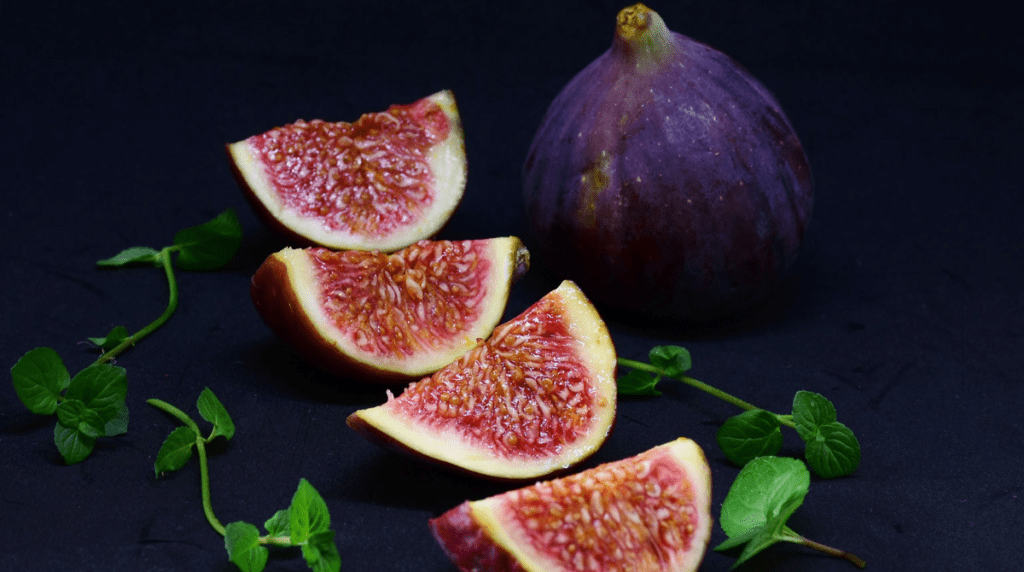Figs are a typical summer and Septembe fruit, with many varieties differing in shape and colour.
Figs are the fruit of the Ficus carica L., and are important nutritional source for adults and children: they are rich in vitamins, potassium, iron, calcium and vitamin B6: 3 figs contain 0. 18 mg of vitamin B6, equal to 9% of the recommended daily intake; they are also rich in vitamins A, B1, B2, PP and C.
The fig is a small deciduous tree with many branches growing up to 6–10 metres tall.
Its fruit is botanically a fleshy infructescence, rich in sugars with a green skin that may ripen toward red or a bluish purple.
The fig fruit develops as a hollow, fleshy structure lined internally with numerous unisexual flowers. The fruit contains numerous unisexual tiny seeds, called achenes.
The flesh surrounding the small achenes is sweet and succulent.

The fruit is particularly sweet to the palate, rich in nutritional properties and can be eaten fresh in season or dried throughout the year.
Fresh figs provide about 50 calories in a 100-gram serving, while a 100-gram serving of dry figs provide about 249 calories.
Dry figs are more caloric as without water they have more concentrated nutrients (and consequently calories).
Fresh figs contain digestive enzymes that help digest food and carry out a caustic and proteolytic action to help protect the skin.
The fruit has many uses: it can be used in a compress for abscesses and inflamed swelling, against boils and can help in urine and lung inflammations, as well in cases of fever and gastritis.
Properties of figs
1) Rich in fibre: they are often recommended in cases of constipation and intestinal problems. They are natural laxatives like prunes and kiwi fruit and are especially effective on an empty stomach.
2) Source of energy: rich in sugars, vitamins and mineral salts, an excellent 100% natural source of energy.
3) Source of calcium: allies for bones and teeth, rich in minerals.
4) Rich in antioxidants: rich in polyphenols, natural antioxidants, which help to keep body cells young.
5) Help to prevent high blood pressure: foods which combine potassium, calcium and magnesium and are low in sodium can help to prevent high blood pressure; these include figs.
6) Help the skin: figs have anti-inflammatory properties and if applied directly to the skin can help with problems like acne. Additionally, their laxative effect helps rid the body of accumulated toxins which can be a cause of acne and other skin problems.
7) Help the immune system: rich in vitamins, minerals and antioxidants, they help the immune system to carry out its functions, protecting our body better from external agents.
8) Improve digestion: figs contain prebiotics, which feed the good bacteria that normally live in our intestine. A healthy gut environment improves digestion and overall wellness.
9) Useful to control glycemia: even though they contain sugars, the presence of mineral salts like potassium and magnesium help to keep glycemia under control. A fig leaf infusion can help control high glycemia after meals.
10) Recommended during pregnancy: dried figs area great snack during pregnancy when you need more vitamins and mineral salts. Their calcium content helps reach the recommended daily amount for the foetus to develop the spine and bones properly.
Curiosities
- For Hindus and Buddhists, figs are the symbol of knowledge and truth.
- If they call you a sycophant, do not be afraid but search your own heart. In ancient times. sycophants (from the Greek sukon meaning fig, and phainein meaning to show) referred to those who unjustifiably accused others of stealing figs from the sacred orchards. Today it means a servile, self-seeking flatterer.
- Plutarch (Greek writer, philosopher and priest) affirmed that in antiquity the fig tree was sacred and was linked to the foundation of Rome. Legend has it that the basket containing Romulus and Remus was not driven by the currents of the overflowing River Tiber but miraculously came to rest in a muddy bank beneath a wild fig tree: under the shadow of this fig, a she-wolf suckled and fed the twin sons of Mars and a vestal virgin. The plant became sacred and was cared for by the priests of the God.
Figs and beauty
Figs can also be used for skin care. Here are some secrets:
- Fig mask
The vitamins and minerals contained in the flesh are extremely beneficial when applied to the skin.
Moisturising, rich in antioxidants and cleansing, figs can be applied to the hands and face in the form of a beauty mask.
Take some ripe figs and mash them with a fork, including the peel.
To make a moisturising mask that will also nourish the skin, mix with a tablespoon of sweet almond oil.
Apply to your face or hands and keep on for about 10 minutes, then rinse.
This mask is excellent for dry skin.
After exposure to the sun, you can soothe your skin and stimulate cell regeneration by mixing fig puree with two tablespoons of olive oil.

- Fig scrub
The flesh and seeds of figs are perfect as a light scrub for delicate areas of the body such as the nek and back of the hands.
If you also want an exfoliant as well as the antioxidant power, just add a teaspoon of sugar, mix in some almond or olive oil and use to scrub your whole body.

Ancient remedies
There are several health remedies from figs that were first used centuries ago:
- the latex or sap from the fig skin when it is picked from the tree is an irritant and caustic; indeed, a grandma’s remedy was to use it against warts and calluses.
- The boiled fruit in a gauze wrap can be used as a compress to treat abscesses, swellings and inflammation.
- A fig infusion was used traditionally to ease coughs and sore throats.


